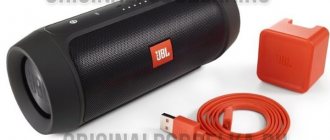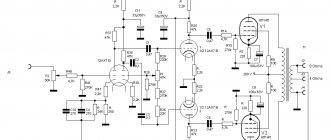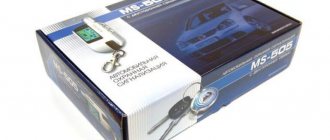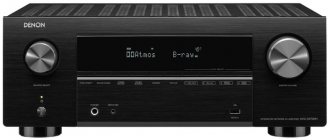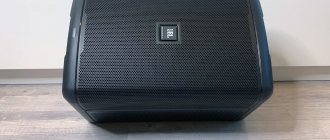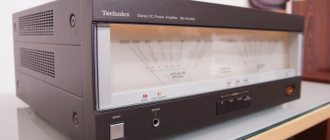Miniature high gain dual triode vacuum tube
| This article in based largely or entirely on a single source . |
| 12AX7 | |
| RCA 12AX7 | |
| Classification | Double triode |
| Service | Class A amplifier |
| Height | 2.2 inches (56 mm) |
| Diameter | 0.8 inches (20 mm) |
| Cathode | |
| Cathode type | Indirectly heated |
| Heater voltage | 12.6 V (series) 6.3 V (parallel) |
| Heater current | 150 mA (series) 300 mA (parallel) |
| Anode | |
| Maximum Watt Dissipation | 1 per section |
| Maximum voltage | 300 V |
| Sockets | |
| Typical Class A Amplifier Operation | |
| Gain | 100 |
| Anode voltage | 250 V |
| Anode current | 1.2 mA |
| Offset voltage | −2 V |
| Anode resistance | 62.5 kOhm |
| References | |
| Sylvania 12AX7 data sheet | |
12AX7
(also known as ECC83[1]) is a vacuum tube that is a miniature high voltage gain 6AV6 dual triode. Designed around 1946 by RCA [2] engineers in Camden, New Jersey, under development number A-4522, it was released to the public under the designation 12AX7 on September 15, 1947.
The 12AX7 was originally intended as a replacement for the 6SL7 family of dual triode amplifier tubes for audio applications. A popular choice for guitar tube amplifiers, its continued use in such equipment makes it one of the few small-signal vacuum tubes in continuous production since its introduction.
Statement[edit]
| In this section do not cite any sources . |
The 12AX7 is a high gain (typical gain of 100) low plate current triode that is best suited for low level audio voltage amplification. In this role, it is widely used for the preamplifier (input and mid-level) stages of audio amplifiers. It has a relatively high Miller capacitance, making it unsuitable for radio frequency use.
Typically, the 12AX7 triode is equipped with a high value plate resistor, 100k ohms in most guitar amps and 220k ohms or more in high-end equipment. The grid bias is most often provided by a cathode resistor. If the cathode resistor is disabled, negative feedback is introduced and each half of the 12AX7 provides a typical voltage gain of about 30; the gain is basically twice the maximum gain of the stage, since the plate impedance must be matched. Thus, half the voltage is applied to the tube at rest, and half is applied to the load resistor. The cathode resistor can be bypassed to reduce or eliminate negative AC feedback and thereby increase gain; The maximum gain is approximately 60 times with a 100 kΩ plate load and a center-biased and bypassed cathode, and higher with higher plate loads. [3]
A v {\displaystyle A_{v))=μ * Rtot / (rP + Rtot + (RK * (μ + 1)))
Where = voltage gain, μ is valve gain, rP is internal plate resistance, RK is cathode resistor and Rtot is the parallel combination of RP (external plate resistor) and Rload. If the cathode resistor is bypassed, use RK = 0. A v {\displaystyle A_{v))
The initial "12" in the designation indicates that a 12-volt heater is required; however, the tube has a center tap heater so it can be used in 6.3V or 12.6V heater circuits.
Electro-Harmonix 12AX7 ECC83 preamp tube
Radio tube 12AX7EH Electro-Harmonix
Produced at the largest NewSensor plant (Saratov), which, under the management of its American owner, produces the best lamps in the world, according to many independent experts.
European marking: ECC83 / ECC83S
Direct analogues: ECC803, B759, 5751, CV4004.
All prices on the site include the cost of selection.
All lamps presented on our website, after standard factory quality control, undergo extremely precise selection according to parameters by Fortress amplification engineers: triode symmetry, minimal microphone effect and anode current of at least 1.2. Which meets the most stringent requirements: V-1 (lamp for installation in the first position)
About the lamp:
12AX7 EH tubes, miniature dual triode. In a pure guitar sound, it manifests itself as extremely musical and balanced in frequency. In overload modes, its reduced tendency to self-excitation is manifested. The sound has a tight lower mids and elastic bass, the upper frequencies are musical without being too sharp. Together, this results in a velvety and rich sound even at high gain. In our opinion, this is the most musical and balanced lamp. This lamp will reveal the full potential of any amplifier, preamp or any other guitar effect or studio device. Marshall, Mesa, and Fender companies install these tubes in their best years, when their budget allows =)
Be carefull!
A huge variety of rejects are sold online: lamps that have not passed export quality control, sometimes without original packaging and even without a company logo on the lamps themselves. Working lamps do not mean sounding lamps. If you have chosen the path of tube sound for yourself, it is probably not because you don’t care how your device will sound. Also, such lamps can harm your equipment. All our radio tubes have original packaging and the manufacturer's logo.
The online store www.firststring.ru and the Fortress amps company are the official dealer of such brands as: Electro-Harmonix, Tung-Sol, Mullard, Svetlana, Sovtek, Genalex Gold Lion and Jj.
Using a lamp in faulty equipment may cause damage to both the lamp and your equipment. High-quality repairs are significantly more expensive than high-quality lamps. Always contact us or trusted specialists in the field for advice on lamp replacement. Remember - tube technology and the radio tubes themselves require a qualified approach - only then does the magic happen called “That very warm and tube sound!”
We deliver radio tubes to all regions of Russia, in any way convenient for you. There is no need to worry about reliable packaging and safe shipment of such fragile cargo. We have been shipping lamps nationwide since 2008.
Similar designs with two triodes[edit]
The 12AX7 is the most common member of what eventually became a large family of two-triode vacuum tubes produced throughout the world, all sharing the same pinout (EIA 9A). In most cases, heaters are used, which can additionally be connected in series (12.6 V, 150 mA) or in parallel (6.3 V, 300 mA). Other tubes that can be used interchangeably in an emergency in some cases include the 12AT7, 12AU7, 12AV7, 12AY7 and low voltage 12U7, as well as a variety of EIA series four-digit dual triodes. They cover a wide range of voltage gain and transconductance. Various versions of each have been designed to provide increased durability, low mic level, stability, service life, etc.
These other designs offer lower voltage gain (giving way to higher plate current) than the 12AX7 (which has a voltage gain of 100) and are more suitable for high frequency applications. A v {\displaystyle A_{v))
Some American developments similar to 12AX7:
- 12AD7 (October 10, 1955 - 225 mA heater - low hum)
- 12AT7 (20 May 1947, twin 6AB4, =60) A v {\displaystyle A_{v))
- 12AU7 (18 October 1946, twin 6C4, [4]=17-20) A v {\displaystyle A_{v))
- 12AV7 (February 14, 1950 - twin 6BC4, = 37-41) A v {\displaystyle A_{v))
- 12AX7
(September 15, 1947 - double 6DR4, same as octal 6SL7, = 100) double 12AV6 (6AV6) A v {\displaystyle A_{v)) - 12AY7 (December 7, 1948 - = 44, to use audio preamplifier) [5] A v {\displaystyle A_{v))
- 12AZ7 (March 2, 1951 - heating element 225mA, = 60) A v {\displaystyle A_{v))
- 12DF7 (=100, low microphone) A v {\displaystyle A_{v))
- 12DT7 (=100) A v {\displaystyle A_{v))
- 12DW7 [6] (First triode: =100, Second triode: =17) A v {\displaystyle A_{v))A v{\displaystyle A_{v))
- 12U7 (=20, for use in 12V plate-powered car radios) A v {\displaystyle A_{v))
Although they are commonly known in Europe under the Mallard–Philips tube designation ECC83, other European variants exist including low noise versions 12AX7A, 12AD7, 6681, 7025 and 7729; European versions B339, B759, CV492, CV4004, CV8156, CV8222, ECC803, ECC803S, E2164 and M8137; and low-noise, low-gain versions of the 5751 and 6851, designed for avionics equipment.
In European usage, special quality valves were often identified by changing the letters and numbers in the name: E83CC was ECC83 special quality. In the US, the "W" in the designation, as in the 12AX7WA, indicates a lamp that meets military standards and higher reliability requirements.
The E in the European designation classifies it as having a 6.3 volt heater, while the US designation 12AX7 classifies it as having a 12.6 volt heater. Of course, it can be connected to operate on any voltage.
Mullard ECC83/12AX7 user manual. How to distinguish a real lamp from a fake?
Hi all! Let me say right away that the ecc83/12AX7 Mullard is one of my favorite tubes, be it an input stage, a cathode follower, a phase splitter, etc. Therefore, to answer potential questions, what sounds better: Mullard or the xxx brand? – I’ll answer right away: in general and on average, yes, in my opinion, Mullard is better for audio. The following, I am sure, is well known to most members of the forum, but maybe I will be able to add something or structure it. Recently in the lamp thread, it turned out that a colleague bought a fake (relabeled) Mullard. Unfortunately, I see such “fakes” on sale all the time. And not only because of the ill will of the sellers, but also because Mullard was at one time acquired by the Philips concern, respectively, cross-rebranding flourished depending on sales needs. True, sometimes, when I saw that people were brazenly asking decent money for a fake, as for a real Mullard, I tried to write to them: how can this be? A real Mullard looks like this and that, but what do you have? Well, I don’t know, they answer, you’re probably right. But neither the description nor the prices changed afterwards. Conscious ignorance? In this essay, by real Mullard we will mean those lamps that were produced at the brand’s English factories. I will not go into the general product range, history and subsequent ups and downs of the manufacturer, I will just tell you a little about their ecc83/12AX7. The correct Mullard is quite different from other brands in its special sound style. Of course, these lamps are not a universal remedy. It all depends on the path. In some places they sound better, in others they don’t. And everyone has different tastes. There are ecc83 lamps that are even more desirable, for example, those made by GEC, Marconi, Osram or the long-board Philips with welded anodes from the Copenhagen plant are also not bad, but these are not readily available and are quite expensive today. I also have not seen any photographs of English vehicles from the 60s ecc83 produced by Brimar, Mazda Thorn, etc. in the original configuration (but this, of course, is not accurate). Obviously, the designers had a choice, but they installed Mullard... By the way, many American audio manufacturers also placed orders from Mullard, and then labeled the lamps with their brands. Selected Mullard lamps were often given the special 7025 marking in the US market. I don’t think that the British could supply ecc83/12ax7 cheaper than local American factories, import duties, logistics, and then no one canceled it. This means it was not a matter of low delivery price. And if the tract is balanced, Mullard can play very emotionally, richly in timbre, without excessive brightness or thinness, with a high degree of listener involvement, which makes them different from other manufacturers, both American and European. Therefore, in the mass market NOS Mullard is sold at premium prices, because... Demand creates supply. Perhaps technically this is explained by the fact that the production had a very strong R&D direction, where huge amounts of money were invested. Thus, both the materials and production technologies at the Mullard factories were the most advanced and unique at that time. Or, in other words, their own, which magically and, most likely, randomly turned out to be good for audio playback systems. Of course, we understand that not a single mass manufacturer has ever put at the forefront “how will its products sound in hifi?” However, Mullard lamps, indeed, and some Brimar STC lamps too, were also produced, as an elderly Englishman I know said, “with audio in mind.” For example, some modifications of lamps were specially modified for government orders for the sound of pharmacies, stadiums, warning systems for the population about a Russian attack, intercoms for military aircraft/submarines, etc. After all, it's audio? So, what kind of ecc83 did Mullard produce and how did they differ in design from other manufacturers? In other words, how, after paying $100 or more for a NOS ecc83/12AX7 Mullard lamp, can you avoid getting caught in a fake or rebranded case? There were two large Mullard factories where the ecc83 was produced: Blackburn and Mitcham (respectively the production codes should begin with B and R). The latter later specialized in military modifications. These are easy to distinguish, since they have box-shaped anodes without any holes, the so-called “boxed plates” (boxed anodes). There are no fakes of the latter. There may be some re-marking, but at first glance you can see that there is a real Mullard inside. We will return to them later, I will tell you which boxed plates are most valued among audiophiles. And so Blackburn... The first ecc83 came from the early 50s. The most desirable and expensive for today. They are all long-anode, the earliest ones had welded anodes, then stamped anodes came - always gray in color, with copper mesh winding rods and have the following types of getter: square getter or cage getter, “basketball hoop” getter "on two legs (goal post getter) and a standard round getter on one leg (round getter). As a rule, at the bottom of the flask there should be a modification number and a production code below it (but not necessarily). The earliest modification with welded anodes was 195X-1954gv (I600), from ~55gv came mC1, then F91, and in 58-59gv F92. Accordingly, mC1 is a square getter, F91 is a goalpost getter and F92 is a round getter. It happens that the goalpost getter has the F92 modification and vice versa. Apparently, at the time of the change of production, an “intersection” arose. They look like this:
Long plates sq getter:
Long plates goal post getter:
Long plates round getter:
I have never come across any fake long-anode Mullards. Cage and goalpost getters - you can't fake them, but with F92 (a regular getter) on one leg you have to be more careful, just in case. Be sure to have copper rods and holes in the anodes, characteristic of Blackburn. Note that the getter silver does not occupy the entire top of the flask. It has a blackish tint. The spout at the top of the flask is never long and sharp - it is always small and “dull”. There are four seams on the top of the long-anode Mullard bulb.
Since 1959 Mullard has changed the design. The anodes became short. This helped reduce internal tube noise and reduce microphonic effects. (Although it is clear that the reason for reducing the internal assembly by 3mm was most likely the desire to save on materials). The very first short-anode lamps (quite rare today) could have nickel or more often copper rods, a round getter, four seams on the bulb and upper mica pads with a full set of teeth (apparently, mica insulators still remained from long-anode models). The codes, like those of the long-anode predecessors, are three-digit: B (a letter indicating the place of production - the Blackburn plant), a number - the year of production and a letter indicating the month of production from the beginning of the year. Model code is I61. It is very difficult to distinguish the Dutch Philips (it sounds so-so) from the earliest short-anode Mullard with nickel rods. If there are no production codes, it is almost impossible. My recommendation: be careful when purchasing unless you are sure there is a real Mullard inside. But there are very few early lamps with nickel rods. If they are copper, then definitely Mullard; Phillips did not make them with copper rods. I61 were produced until 1964. Since 1960, all short-anode Mullards have had one IMPORTANT UNIQUE DISTINGUISHING FEATURE - the absence of teeth on the upper mica platform between the anodes. This is the simplest and most obvious sign of a genuine Mullard. And the subsequent I62 and I63 until the very end of production had two seams and did not have teeth between the anodes. There are no teeth - Mullard, there are teeth - the question is most likely a re-marking of something else. Photo of an early short-plate Mullard still with a full set of teeth and nickel rods:
Then briefly... until 1967, all Mullard lamps had copper rods. These lamps sound better. Since 1966, nickel rods have been introduced; the straight (vertical) getter leg made of copper rod has been preserved. Still a good sounding tube, but less interesting than earlier modifications, IMHO. At the end of the sixties, the so-called new shield Mullard came into use (however, on some of these lamps the shield may be of the old type - old shield). Distinctive feature: a curved L-shaped getter leg, onto which a getter ring is soldered on top, and only nickel rods. As a rule, in these lamps the evaporation of the getter occupies a larger area compared to lamps of previous modifications and has the usual silvery, rather than blackish, sheen. The sound of the “new” Mullard is completely different, very different from everything that was in earlier releases. Somewhere in 1975-1976, the manufacturer curtailed production.
Photo of Mullard from 1960 to 70 - no crenellations anywhere on the top platform:
Thus, when buying a sound-correct short-anode ecc83 Mullard from 1960 gv from the Blackburn plant, you should pay attention to:
- Are there two seams at the top of the bulb?
- Are there any teeth missing on the top mica pad between the anodes?
- Are the mesh winding rods made of copper?
- Is the getter spray blackish in color?
- Is the flask nose blunt and short?
- What about the production codes, if any?
Also take into account that all Mullards ecc83 from Blackburn (except for the latest modification I63 new shield with a curved getter leg, but it sounds, I repeat, not as great as the classic Mullard, for which it is valued) to one degree or another have internal noise. It can be quite high to the extent that in a sensitive path, say in a phono stage, it will give the effect of hissing through the speakers. It is ideal if the seller has selected low-noise lamps if you have a sensitive path. Well, or how lucky...
Now a little about lamps from the Mitcham factory, or about box anodes. These are, as a rule, “silent”, but a little more linear, with a less “thick” timbre than the “civilian” Mullard. I know of three modifications. The first, the earliest with a square getter, then the same, but with a ring getter “on a bracket”, then with a round getter on an L-shaped leg, then with a getter on a straight leg. In terms of desirability and sound quality, as usual: from early modifications to newer ones. For early lamps, prices can reach absolutely crazy values, comparable, if not higher, than for long-board Mullards mC1. The print on the flask, as a rule, has its own characteristics. Instead of ecc83, the markings are: 6057, cv492, CV4004, M8137. There may also be rebranding by another manufacturer, usually the Philips group. This lamp carries factory codes 641 and the production date designation begins with the letter R. In my opinion, it is a very good lamp. If you have the opportunity, be sure to try it.
An example of a military tube with a square getter (the best in sound):
With L leg:
Round getter on a vertical leg:
There is also a separate modification specifically for audio, called the 10M Master Series (designed for ten thousand hours of operation and had a two-year manufacturer’s warranty!). I didn't have any of those. I believe the brand only exported these tubes to the US from the mid-sixties to early seventies under the IEC Mullard label. True, I have also met these 10Ms under the label of wholesalers such as Realistic, National, Standard, etc. 10Ms can have gold legs - the most desirable option, or standard ones. May have their own production codes or standard Blackburn codes, in the latter case I suspect it is a regular selected Mullard. It seems that some lamps with gold legs have a getter ring that is larger in diameter than the standard I63 modifications. A good friend of mine described their sound as very rich in timbre, with a less pronounced roll off at the top, very quiet tubes - ideal for an expensive phono stage. Is it recommended for purchase by wealthy audiophiles? Without a doubt! Then please share your impressions with us mortals!
Example 10M with gold pins:
Well, here's a quick look at the ecc83/12AX7 Mullard. Still have questions? I'll try to answer. Missed something important? Help, add!
Links[edit]
- https://www.thetubestore.com/Tubes/12AX7-ECC83-Tube-Types
- ↑
Jung, David (September 2010).
"Draw! A 12AX7 'Shootout'". Vintage guitar
: 114. - https://www.ampbooks.com/mobile/amplifier-calculators/output-impedance/calculator/
- https://www.thetubestore.com/Tubes/6C4-M8080-Tube-Types
- https://www.thetubestore.com/Tubes/12AY7-6072-Tube-Types
- https://www.thetubestore.com/Tubes/12DW7-7247-Tube-Types
- https://www.tube-fullmusic.com/products/en/12AX7_en.htm

